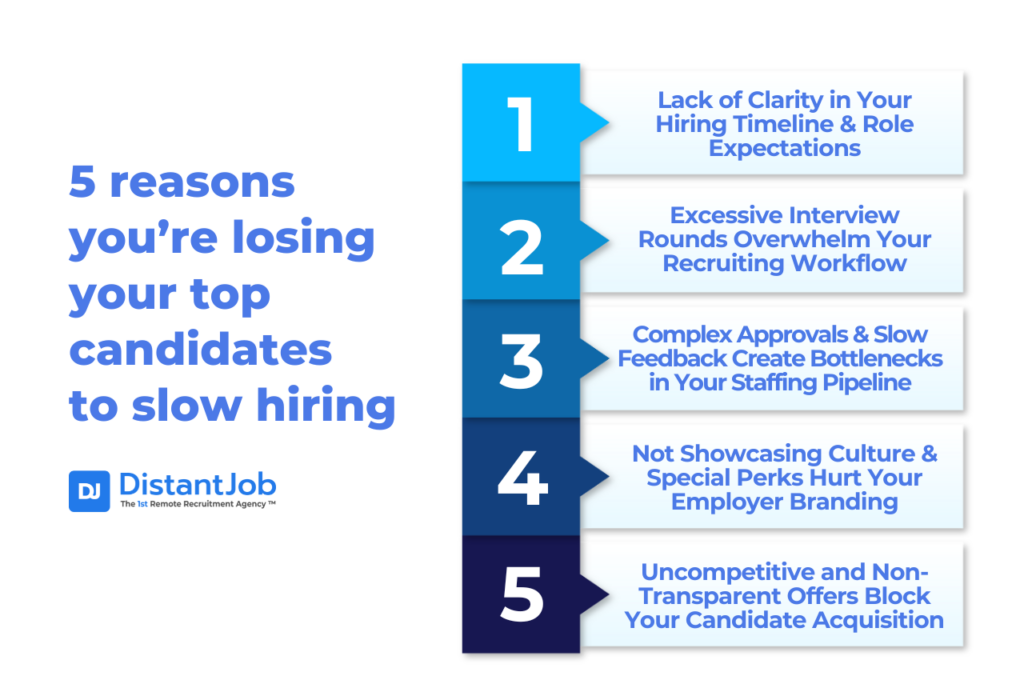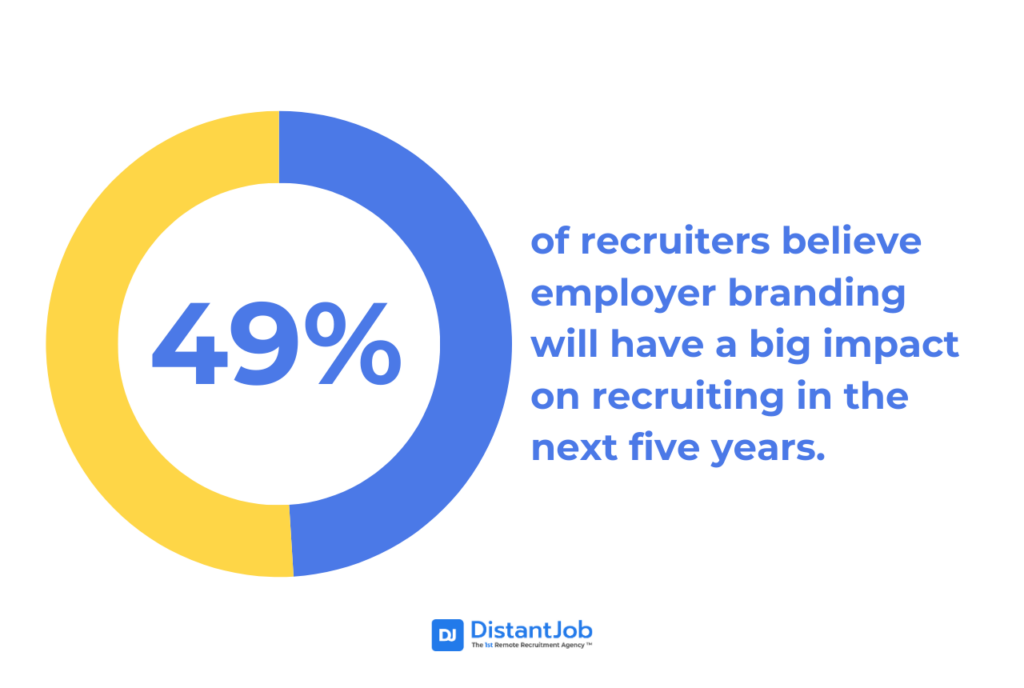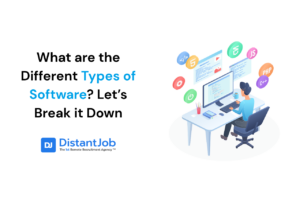The reason why you’re losing good candidates to a slow hiring process is rather simple: the best candidates don’t wait around. In fact, nearly 60% of them give up on applications that are either too long or complicated. So if you’re working with a slow hiring process filled with too many interviews, poor communication, slow choices, and unclear role expectations, it’s no wonder why you’re losing the top talent you’ve been able to attract.
The good news is that you can turn things around. To help you do that, here are the top 5 reasons you’re losing your top candidates to slow hiring, and how to fix it.

Reason #1 – Lack of Clarity in Your Hiring Timeline & Role Expectations
The Problem
When your hiring timeline and your role descriptions are vague, it becomes difficult for your recruitment team to stay organized and accountable, leading to prolonged decision-making and unnecessary delays that not only extend the overall process, but ends up losing you top candidates who prefer moving on to more efficient employers.
That happens because as humans we naturally seek stability and clarity—we like to know where we are and where we’re going, so we can process and prepare. This desire is equally important during the hiring process. 78% of candidates expect frequent communication throughout the hiring journey, yet only 37% actually get updates. As a result, they feel left in the dark, and quite frankly, unappreciated, which ultimately leads them to consider other career opportunities in the talent acquisition scene, which in turn means you find yourself repeatedly searching for new candidates, dragging your staffing pipeline even further.

Adding to the trouble, we have the unclear role expectations issue. If your job descriptions are unclear and responsibilities aren’t clearly defined, it makes it hard for applicants to figure out if they’re a match for the role. In turn, this can impact your hiring workflow in two ways:
- Your hiring process could be seen as disorganized, making skilled candidates think twice before applying, and
- You could end up attracting applicants that are unsure if they’re a right fit but are willing to try out, which means you could be wasting your time screening them, since they might not be the one for the position, anyway.
The Fix
- Set a ‘Hire-By’ Date:
- Schedule key milestones within 2 to 3-week timeframe from the starting date. Use shared calendars or project management tools such as Asana or Trello to keep everyone on the same page and prevent delays and hiccups when it comes to making decisions.
- Communicate Open and Clearly:
- Get your candidates in the loop, share with them openly what’s coming—how many interviews there will be, who they’ll be meeting with, when you expect to be making decisions, and when they can expect updates. And don’t underestimate the power of a simple message letting them know something like “We’ll get back to you within 48 hours”.
- Give Them a Full Picture of the Job:
- Candidates need to know what they’ll be doing, the tasks they’ll be performing, who they’ll work with, the structure of their department, and how performance is measured, so they can also assess if they’re a fit for the position themselves. So provide comprehensive details about the role, including daily responsibilities, team structure, and performance metrics
The Result
By setting clear timelines and communicating openly with candidates, you not only enhance candidate experience (leading to better outcomes in your recruitment journey), but you make sure your hiring team stays organized and accountable. When everyone follows the same schedule, there’s no reason why unnecessary delays should happen, and so, by following the strategies above, you can definitely prevent them.
As a result, decisions get made quickly, keeping the whole recruitment process moving along at a great pace, which ultimately leads to faster and more successful hires.
Reason #2 – Excessive Interview Rounds Overwhelm Your Recruiting Workflow
The Problem
Having a long interview process is definitely one of the biggest reasons companies lose good candidates. Each extra round—be it an interview with another stakeholder or a coding test—extends your recruiting timeline, making the process even slower, longer, and tiring. That doesn’t sit well with candidates, especially the ones being approached with other job offers, who not only get frustrated about how long it’s taking, but also about why it’s taking that long, making them start wondering about your company’s organization and planning abilities, which could make them hesitant to commit to you down the line.
The Fix
- Combine Interviews Where Possible:
- Instead of having one interview for each type of assessment, combine them: assess both cultural and technical fit at the same time, for example. Also, use video interviews to your advantage, as research indicates video interviews can increase hiring efficiency by almost 67%, especially early on in the screening phase.
- Cap It at Three Rounds:
- Although the traditional interview process has 5 stages, we suggest you keep short and sweet at 3 stages tops, as it reduces your overall sourcing process significantly. To do so, include key decision-makers and pack necessary evaluations into fewer well-planned sessions. Besides, add asynchronous video Q&A or skills tests where and if they fit to speed up the process while maintaining screening quality.
The Result
By cutting down on interview rounds, you not only make your assessment cycle faster, you also impact your overall sourcing journey’s length, which, in turn, boosts your TA game. Because, as a result, your candidates feel less frustrated and uncertain, making them more likely to say yes to your potential future job offer.
Reason #3 – Complex Approvals & Slow Feedback Create Bottlenecks in Your Staffing Pipeline
The Problem
Imagine your candidates are sticking around—they’ve gone through some rounds of interviews and they seem interested, but no decisions have been made yet. Besides, you haven’t reached out to them, which also leaves in the dark. This combination is a dangerous one and can hurt your hiring efforts, as 46% of candidates lose interest if they don’t hear back within one to two weeks after their interview. In fact, most expect the recruitment process to finish pretty soon after the interviews are done. So when all you have to give them is long silence they’re that much more likely to disregard your possible future offer.
And this not only prolongs your staffing pipeline, it creates gaps in it, forcing you to continuously look for new candidates, keeping your recruitment team in a never-ending loop that doesn’t always end with a hire.
The Fix
- Get Everyone on the Same Page Early On:
- Get all stakeholders involved and meet with them before interviews start, so everyone can both agree on must-have criteria and choose a simple sign-off process, making it so your candidates won’t have to wait for weeks (if they do).
- Two-Day Feedback Rule:
- Make it a point to get in touch with candidates within 48 hours after any interview. And let them know it, so they can expect it.
The Result
When you make sure your team works is equipped to make decisions fast, since their approval chains are simple and in place, and their feedback game is on point, consistently keeping candidates in the loop, you reduce your hiring timeline significantly. As a consequence you get what you want: a pool of engaged and interested candidates for you to pick and hire from.
Reason #4 – Not Showcasing Culture & Special Perks Hurt Your Employer Branding
The Problem
One of the reasons why your talent acquisition strategy might not produce the fastest and best results, even if you’ve fixed the previous ones, is an inability to showcase your company culture and the benefits employees get when working with you, which hurts your employer branding. This is important because it might be just what your candidate needs to want to join the team. And if they don’t really understand what your company is all about and unique advantages they might be getting, your process might not just drag on even further, but you could lose your top matches.
The Fix
- Share Real Stories & Get Your Team Involved:
- Instead of vague claims, really share with your candidates examples and real stories that highlight your company’s values and team spirit. This could be done either through telling them about a story that does the job, or better yet, through getting your team involved, which means letting them meet potential coworkers during interviews. When you do this, you allow them to get a sneak peek of what working with you would be like and the environment they can expect on a day-to-day basis, allowing them to bond with your culture.
- Show What Really Counts:
- Focus on the perks and benefits that matter—things like flexible hours, mental health days, money for (co)working spaces, and solid chances to grow their career, such as training budgets and mentoring programs. By doing so, you give applicants an even better idea of what working with you would be like and how this opportunity could boost not only their professional life, but also their personal one as well. Besides, if you’re running a hybrid or a fully remote business, here’s your chance to highlight how your team deals with asynchronous collaboration: how flexible schedules are across time zones, if there are any core overlapping hours, and the specific tools your team uses and they will too, if they’re hired.
The Result
A LinkedIn research shows that 49% of recruiters believe employer branding will have a big impact on recruiting in the next five years, as it is the number one area seeing their budget growing bigger (for the second year running, to say the least). These numbers show just really how crucial it is to exhibit your company as the place to work at, be it in a traditional setting or a hybrid/remote one. So, when you follow the strategies above, you attract candidates who might just be a perfect match and shorten how long it takes to actually hire them, allowing you to hire not only faster but to hire right.

Reason #5 – Uncompetitive and Non-Transparent Offers Block Your Candidate Acquisition
The Problem
Last but not least, let’s say you’ve reached the final step in your candidate funnel, and you’re ready to make an offer. Your recruitment timeline may or may not have been too lengthy by now (especially if you’ve managed to follow our tips so far), but that doesn’t mean that your offer couldn’t change that. The truth is, the job market is tough, which is making it harder for recruiters and companies to snatch talent. Candidates often have many offers coming in, and if yours doesn’t seem like the right one, your process could be delayed even more, and of course, you could end up losing your candidate.
If you’ve been able to position your company well by this point, they might want to negotiate, which could be good, of course, but could also delay the hiring. And, well, they might decide to altogether refuse your offer.
The Fix
- Talk About Pay Right Away:
- It’s important your candidates know from the get-go how much you’ll be willing to offer, a clear range. This helps set and align real expectations, making sure no one feels blindsided. Also, if your company offers any bonuses, more days off, or international holidays, let them know. All details matter and can make your offer look more tempting.
- Customize the Deal:
- Make an effort to understand what your top candidates need, value, and want out of working with you—be it flexible schedules, chances to grow, or unique team experiences. Then, use this info to shape your final offer to match these specific motivators. For example, if ongoing learning is crucial to them, you could suggest a larger training budget. Ultimately, when you line up the offer with what the candidate cares about, you create a package that’s hard to turn down.
The Result
When your applicants know from the get-go what to expect salary-wise and feel like they matter to you through your customized offers, their satisfaction increases and also their willingness to join your team. As a result, you significantly shorten your hiring timeline, and in turn secure your top talent before competitors have any chance of snagging them away.
Key Takeaways
- Make things clear: Set a 2-3 week timeline to hire where everyone’s roles are clearly defined, and let your candidates know about it.
- Keep interviews short: Limit your interview rounds up to 3 rounds (or less, if possible) to keep your top candidates interested.
- Simplify approvals and feedback: Get your decision-makers on the same page (and on the same schedule) and update, update, update your applicants.
- Highlight culture and benefits: Tell real stories, get team members involved, showcase growth opportunities and hybrid/remote work possibilities.
- Be open about pay: Give clear salary ranges up front and customize package deals to make your offer that more attractive.
The Bottom Line
Now that you know the 5 top reasons why you’re losing good candidates to a slow hiring process and how to fix them, you can turn things around. By implementing the strategies we’ve shared with you, from keeping things clear and open, limiting rounds of interview, showcasing your employer branding, and so on, you can definitely turn your recruitment strategy into an effective system that not only attracts the best candidates, but actually seals the deal and brings them home to your team.
And if these changes feel overwhelming for your team, don’t worry—we’re here to help. Through partnering with us you not only forget the troubles of a lengthy and difficult hiring process, you get only top talented candidates who are a perfect fit for your business, teams, and projects. Besides, we deal with other complexities such as paperwork, payroll, and compliance, making it all that much easier for you. And, to top it all off, at a fraction of the time and a fraction of the cost.
Ready to enhance your hiring process? Schedule a discovery call with DistantJob right away and let’s get started.





